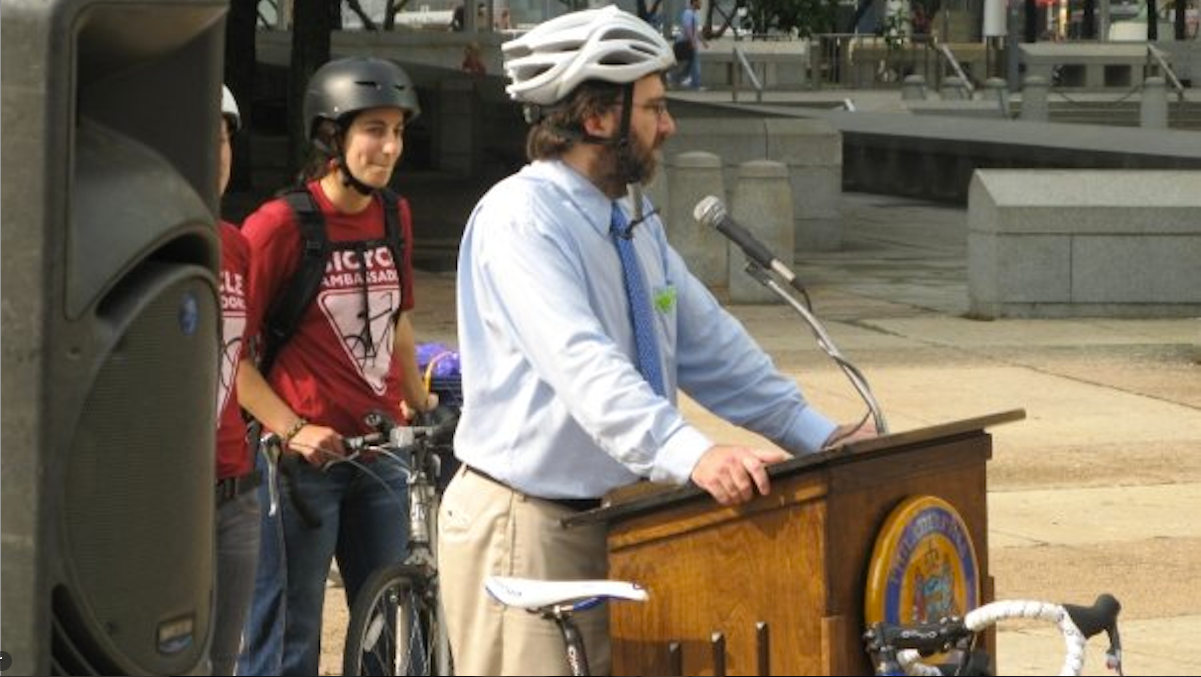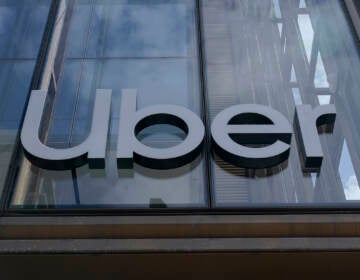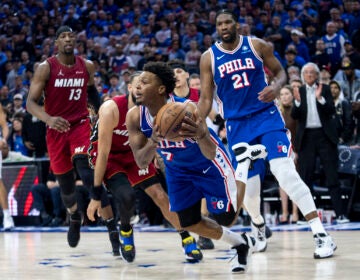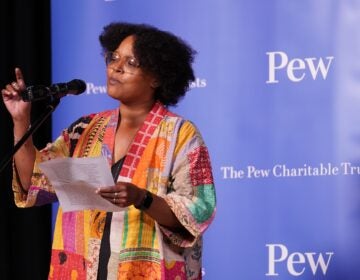Bicycle Coalition director on how next mayor can make Philly bike-friendlier

Alex Doty, executive director of the Bicycle Coalition of Greater Philadelphia, spoke about what his group wants from the city's next mayor. (Image courtesy of the BCGP)
The “Better Mobility Philadelphia 2015 platform” includes 10 transportation strategies to which the group would like to see mayoral and council candidates commit.
On Thursday night, the Bicycle Coalition of Greater Philadelphia’s (BCGP) “Better Mobility Working Group” will co-host a forum so citizens can hear Philadelphia’s mayoral candidates’ stances “on transportation policy, infrastructure and all the issues covered in the Better Mobility and Safer Streets reports.”
The “Better Mobility Philadelphia 2015 platform” includes 10 transportation strategies to which the group would like to see mayoral and council candidates commit.
Those strategies are:
Adopt a Vision Zero policy to reduce traffic crashes (which is the subject of an upcoming “Ask the Mayoral Candidates” feature),
Connect the on-street bikeway network and improve bicycle policies,
Enhance accessibility to public transit,
Ensure access to bike share,
Build 25 miles of circuit trails,
Bring Philadelphia streets into a good state of repair,
Prioritize transportation policy and implementation,
Improve the walkability of streets and sidewalks,
Enliven Philadelphia’s streets and
Manage on-street parking for efficient and effective use.
One recent Friday morning when Philadelphia streets were still covered with ice, NinetyNine caught up with BCGP Executive Director Alex Doty to talk about the platform and, among other topics, how mayors through the years have treated these transportation issues.
Here are the highlights of that conversation:
NinetyNine: When did mayors start taking these issues seriously?
Alex Doty: The first big step that happened for bicycling in Philly as we see it, know it, today was getting bike lanes in. Today, bike lanes are accepted as a piece of municipal infrastructure that any city that proposes to have any mix of transportation needs to have, but that was not always true.
We really had to fight to get the first bike lanes brought in. I think [the first bike lane] was on Delaware Avenue. … They were part of [former Mayor] Ed Rendell’s campaign commitment.
It was a wide-open primary and the Bicycle Coalition had a questionnaire and the question was “Are you willing to put bike lanes in the city of Philadelphia?” It took a couple years after that election for the Bicycle Coalition to get that converted into a plan.
As happens with a lot of bicycle infrastructure stuff, it’s not as if you can build one thing; you need to build a network. That network took time over Rendell’s administration.
In some ways, it really looked like there was a lot of progress made under the [John] Street administration because bike lanes continued to be installed, but it was because of the planning and work that had been done during the Rendell adminstration.
What happened with that network was the Streets Department puts in bike lanes when they repave. So one of the things that people tend to forget is that one of the early complaints about bike lanes, and it was a legitimate complaint, was that they didn’t go anywhere. You’d have 10 blocks here and four blocks there, and ‘why on this street since it’s not a terribly important bicycling street?’
It took 5, 6, 7 years of installing bike lanes in order to actually start to see this network start to take shape on the streets.
There was a very smart and motivated Streets Department employee, his name is Tom Branigan, who volunteered himself to be the “bike coordinator” for the city. His approach was that we should put in the easy stuff first and then you figure out how to do the connectors. You have to show there’s volume on the easy stuff before you do the hard stuff. …
The one thing that was really impressive when the Streets Department started to do this, it really got baked into how they do things.
There really weren’t any significant changes after the election with Street. Towards the end of his tenure, he did make sure there was funding for a partial pedestrian plan for the city of Philadelphia. That was something which accelerated under Nutter as soon as he came in, and also found funding for the second half of the bike plan.
You also saw some moves toward trail building in the Street administration.
99: Were things asked of Street that didn’t go anywhere, or was progress being made so it wasn’t necessary at that point?
AD: Street really didn’t see any priority in setting transportation policies for the city. It wasn’t that he was disrespecting bikes in some way. My impression was that there really wasn’t anybody setting transportation policy, nobody on the mayor’s side who was taking that on as a policy goal.
Today, the Mayor’s Office of Transportation and Utilities is a robust shop; under Rendell, it wasn’t as big an operation, but there were still several people who were thinking about transportation policy. They sometimes struggled how to execute that with the Streets Department, but there were at least people whose job it was to think about this and advocate for it. That wasn’t happening in the Street administration.
99: Were these issues on candidate Nutter’s platform?
AD: When Nutter ran, there were people who were thinking about bikes on his policy team. We also had a questionnaire that we sent out to all of the candidates, and Nutter came back with strong answers on a number of them.
We had several priority issues that we addressed, one of them being that we need to have a full-time bike-ped coordinator for the city of Philadelphia since we were the largest city without one at the time.
We had really, under the Street administration, started to make headway on the trail system on the Schuykill and the trail system on the Delaware. That’s come a long way, but we were saying there needs to be an on-street connecter between them.
We had 215 miles of bike lanes, more miles of bike lanes than any other city in the country, but they didn’t serve our most bicycled neighborhoods. Center City had something on 22nd Street and something on Spring Garden and that was it for one of the most-bicycled neighborhoods in the country.
99: How did it improve when Nutter came in?
AD: Three things.
The mayor establishes a policy shop for transportation and actually gives it operational say.
Then, you bring in a bike/ped coordinator and built on that, as several people are now working on these issues within the city of Philadelphia.
And then, [they] put together a connector between the Delaware and Schuylkill, the Spruce and Pine bike lanes. We asked for that because we wanted to see a connector going across Center City. What was really nice about that ask is that we could relate to it as saying we need to have that bike infrastructure in there, but the mayor could also relate to it because it was like, “right, I need to develop these two waterfronts and this connector is a really important piece of that.”
Spruce and Pine gave a significant new amenity for bikes and, by the city’s measurements, has had no impact on the travel times for motorists going across those streets, and has reduced motor-vehicle crashes on Spruce and Pine by 24 percent. That last piece was completely unexpected by us. …
At the end of the day, it’s a Philly solution, we’re going to have to keep finding these. Nobody has a lock on use of the roadway in the city of Philadelphia. Motorists don’t. Pedestrians don’t. Transit doesn’t. Bicyclists don’t.
We’ve got to figure out a way to co-exist. We’ve got to find a way to make this work. We need to share the roadways and we all need to follow the rules. When we’re walking along, we gotta put our phones down. Bicyclists gotta start figuring out the difference between green and red. And motorists gotta slow down and be conscious of the fact that you’re in a two-ton vehicle that kills people so you need to act responsibly.
99: Why has it gotten worse for pedestrians?
AD: We should be answering that question by doing more analysis and having more data. One possible reason is that the manufacturers of cars have managed to make cars much more safe for the occupants and have not focused nearly as much attention as making the cars safer for people who are not occupants.
The lack of enforcement of traffic laws, you can certainly talk about that in Philadelphia. That’s not Nutter’s problem or Street’s problem or Rendell’s problem, that’s just a thing that’s happened, that we’ve accepted that we don’t have enforcement of traffic laws.
We need to be thinking about new ways of approaching this, and that’s a big part of Vision Zero. The Police Department is really starting to embrace analysis of data leading to having police officers at the right place at the right time.
99: Is there a danger of any of these advances going away?
AD: I don’t see anything getting rolled back. We see a bigger threat in that we are underfunding transportation investment in the city and we’re particularly aware, as bike advocates, that if the larger transportation system is underfunded, then our piece is not going to get funded. The bicycle only works as a functioning part of a system if the whole thing is operating as a network. …
We have a crisis. We should be repaving 130 miles of road a year and last year we did less than 30. So, that’s a problem. And, the other thing that Philadelphia and the region does is look to the state and feds to fund most of our transportation needs, and that’s not true of other big cities. We have just about the lowest rate of per-capita spending. Baltimore is spending 10 times what we’re spending. Pittsburgh is spending four or five times what we’re spending.
But you’re asking this at a time when the School District is running a $100 million deficit, so how is it that you deal with this? Part of my role as an advocate is to say to continue like this and the school district will have a problem even getting its students to schools let alone everything else that needs to function for business to thrive.
The good news is that there are a number of things that can be done for safety and bike/peds that are about better coordination with the resources that we already have, but we do have to find a solution to the problems with repaving.
If we keep kicking this can down the road, this is a crisis in waiting.
99: What is the best case and worst case scenario related to the election?
AD: Philadelphia doesn’t have a physically protected bike lane yet. We’re the last city that aspires to any kind of bicycle-friendliness to do that.
Mayor Nutter, from our point of view, is to be commended for getting proected bike lanes in. … The sky did not fall when they went in.
There is an opportunity for the next mayor to take things that have been successful and to put in enough staffing to do the things they’d like to do and increasingly care about doing, which is a great thing. It used to be that we’d go the Streets Department and they’d tell us no; now we go there and they say yes but they don’t have the resources necessary to get it done.
That’s been one the great accomplishments of Rina Cutler as the deputy mayor of transportation and utilities; the traffic engineers in that office have really bought into the kind of changes that bring about safety for all road users that we have really been asking for.
99: It seems like you have to have a lot of patience in this effort.
AD: Yeah. We started off by talking about bike lanes and we get the win, the bike-lane network, and then it takes five years for that to manifest itself. … This is the way projects go, this is part of the pace of things. The Boardwalk comes in, but our work on that was done four years ago, for whatever slice of that we can take credit for. So yes, patience, for sure.
With elections and mayors, to do something new, that’s going to happen in the first year or two of a new administration, that’s when the campaign promises come into play. After that, it’s about the relationships you have, and how you’re partnering with the administration.
How it is that you build on those campaign promises is how it is that you do things in the second half of administration, which is how bike share is coming. Now you have an administration that’s thinking ‘what’s the capstone’ on their administration. For Mayor Nutter and bicycling, that’s bike share.
The thing that really heartens me about best case and worse case is that for a long time, bicycling was a Center City thing, it’s a milennial thing. Rendell was the Center City mayor; Street was neighborhoods. What’s this next mayor going to be? We are trying to talk about bicycling and walking and Vision Zero; those are things that are important all across the city. …
In bringing bike share, one of the things Mayor Nutter has been very clear on is that he wants us to have the most diverse ridership of all the cities with bike share. So, we are taking almost a third of the stations and putting them in low-income communities.
The thing we try to get across when we talk to the mayoral candidates is that this is not just about the information-age workers riding to the Comcast Tower. Yeah, that’s a compelling argument for biking, but that’s not the entirety of it.
This is the most comprehensive work we’ve ever done in preparation for a mayoral election and we are extending this, also, to City Council. We have met with each of the viable candidates so far, which is a chance for us to discuss this in depth for about an hour. Then, we have the forum, which is a chance for them to talk publicly about it, and we can write down what they’ve said. …
We’ve been here for 40 years, and we’ll be here for another 40, we’re paying attention and we’re also there to help figure it out. It’s not simple; if it was, it’d already have been done.
WHYY is your source for fact-based, in-depth journalism and information. As a nonprofit organization, we rely on financial support from readers like you. Please give today.




